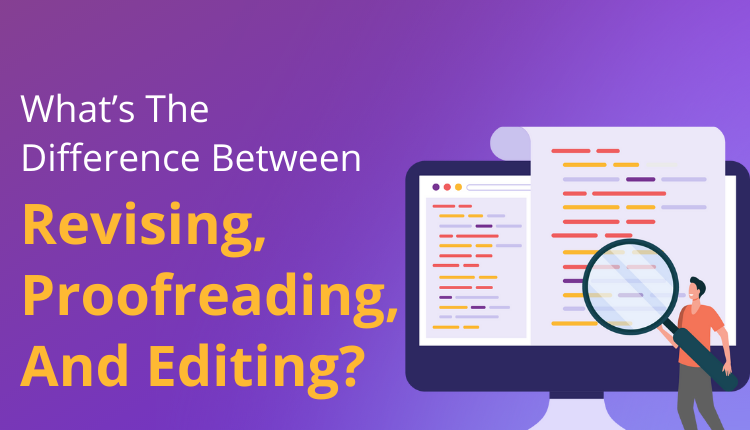Revising
Revision begins with a re-read of your work and is focused on big picture changes like organization, flow, transitions, evidence, and content.
Editing
Editing is about making changes to sentence structure and phrasing.
Proofreading
Proofreading is the final review to catch any minor errors that were missed in the revising and editing stages
Writing is an essential part of research, and every student spends time learning how to write. But just knowing how to write isn’t enough. To create perfectly polished work, even the best writers spend time revising, editing, and proofreading their work. Many people use these three terms interchangeably, but in fact they are very different processes.
So what’s the difference between revising, proofreading and editing, and do you need to pay someone to do them for you? Let’s talk about what it means to revise, edit, and proofread a paper, some tools that can help, and why you should do all three of these steps each time you write.
Table of Content:
What is Revising?
After you’ve written a first draft of the paper, the first step you’ll want to take is to revise your work. Revision begins with a re-read of your work and is focused on big picture changes like organization, flow, transitions, evidence, and content.
When you read your work again, ask yourself if any content needs to be added or removed. Are all of your claims backed up with sufficient evidence? Are you missing any citations? Does the organization of the writing make sense? Does the logic flow smoothly from one section to the next? Are there any transitions that need to be reworked?
When you revise your paper, it’s an opportunity to really interrogate your work and fix any major problems that you find. You don’t need to worry so much about typographical errors or word choice at this stage—you’ll fix those problems later.
Right now, ask yourself if you can follow your argument and whether you’ve provided the appropriate facts and citations to support it. This is the time to delete or add sections of writing, move paragraphs around, and generally make any big changes that are necessary.
What is Editing?
Once you’ve finished revising your paper, it’s time for the editing stage. If revising is about making big, sweeping changes to the structure and organization of your paper as a whole, editing is about making changes to sentence structure and phrasing. Editing focuses on whether your writing clearly conveys what you want to say.
As you edit, you should examine word choice, whether any sentences are too long or short, and whether punctuation is correctly applied. This is also the stage during which you should ensure that your paper follows the appropriate citation format.
Does your paper need to conform to the MLA, APA, or Chicago styles? Have you formatted your headings in the appropriate title case? Is your bibliography properly organized in accordance with your paper’s citation style? Is the tone of your paper suitable for your audience? All of these issues should be addressed in the editing stage.
What is Proofreading?
Once you’ve finished editing, it’s time to proofread your paper. Proofreading is the final review to catch any minor errors that were missed in the revising and editing stages. When you proofread, you should be looking for any spelling errors that a traditional spellchecker won’t catch (writing “form” instead of “from,” for example), capitalization and punctuation errors, and formatting issues.
This is the time to get very fussy about details. Page breaks, table of contents, font, sizing, headings, citation formatting, punctuation inside or outside quotation marks, consistency—you should make sure all of these are correct while you proofread.
By the time you’ve reached the proofreading stage, you have probably spent a lot of time reading and re-reading your own work. This means it can be easy to miss minor errors because you know what it is you intend to say, and your brain can trick you into not seeing your own mistakes.
For this reason, it is usually best to spend at least two to three days away from your paper before you proofread it. That way, you can look at it with fresh eyes. It can also help to divide up your paper into sections and proofread it, read it out loud, or ask a friend or colleague to help you out.
Do You Really Need to Revise, Edit, and Proofread?
Do you really need to revise, edit, AND proofread your paper? It can seem like overkill to read and re-read your own work over and over looking for mistakes. But in fact, all of these steps are essential to ensuring that your writing is the best that it can be. All three of these steps address different problems with your writing, and skipping any of them is likely to result in avoidable errors making it into your final draft. Even the best quality research can fail to make an impact if the writing is of poor quality or difficult to follow.
If you aren’t confident in your ability to revise, edit, and/or proofread your own writing, there are numerous professional academic editing services available. These services offer careful reviews by professional editors in every academic field, and you can select which service you need.
Alternatively, there are many great AI writing tools that can help improve your writing as well. AI writing tools like Trinka that are specifically targeted toward academic writing will check to make sure that technical terms are used properly and citations are accurately formatted.
Whether you choose to use an AI writing tool, hire a professional, or revise, edit, and proofread your own work, doing so will certainly improve your writing and enhance your chances of being published. For optimal results, using a grammar checker can help ensure your writing is flawless and error-free.


Comments are closed, but trackbacks and pingbacks are open.